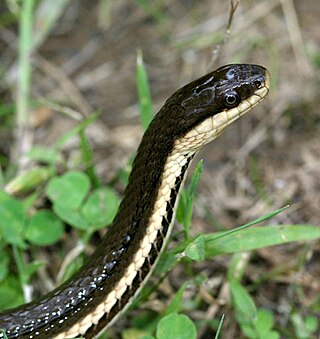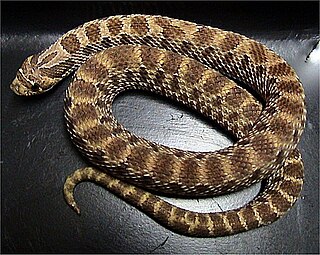
Pantherophis vulpinus, commonly known as the foxsnake or the eastern fox snake, is a species of nonvenomous rat snake in the family Colubridae. The species is native to North America.

The long-nosed snake is a species of nonvenomous snake in the family Colubridae. The species is endemic to North America. It has two recognized subspecies. The other species in the genus were previously considered subspecies.

Masticophis is a genus of colubrid snakes, commonly referred to as whip snakes or coachwhips, which are endemic to the Americas. They are characterized by having a long, thin body and are not dangerous to humans.

Sonora is a genus of small harmless colubrid snakes commonly referred to as ground snakes, which are endemic to North America.

Salvadora is a genus of colubrid snakes commonly called patchnose snakes or patch-nosed snakes, which are endemic to the western United States and Mexico. They are characterized by having a distinctive scale on the tip of the snout.

Tantilla is a large genus of harmless New World snakes in the family Colubridae. The genus includes 66 species, which are commonly known as centipede snakes, black-headed snakes, and flathead snakes.

Storeria is a genus of snakes in the subfamily Natricinae of the family Colubridae. The genus is endemic to North America and Central America. The genus consists of five species, four of which are known as brown snakes, and one of which is known as the redbelly snake.

The Natricinae are a subfamily of colubroid snakes, sometimes referred to as a family (Natricidae). The subfamily comprises 36 genera. Members include many very common snake species, such as the European grass snakes, and the North American water snakes and garter snakes. Some Old World members of the subfamily are known as keelbacks, because their dorsal scales exhibit strong keeling.

Regina is a genus of semiaquatic natricine colubrid snakes known as crayfish snakes, named after their primary choice of diet. The genus consists of two species which are found in the eastern and central United States.

Rhinocheilus lecontei tessellatus is a subspecies of nonvenomous colubrid snake, which is native to the western United States and northern Mexico.

The western hognose snake is a species of snake in the family Colubridae. The species is endemic to North America. There are three subspecies that are recognized as being valid, including the nominotypical subspecies.

The Colubrinae are a subfamily of the family Colubridae of snakes. It includes numerous genera, and although taxonomic sources often disagree on the exact number, The Reptile Database lists 717 species in 92 genera as of September 2019. It is the second largest subfamily of colubrids, after Dipsadinae. Many of the most commonly known snakes are members of this subfamily, including rat snakes, king snakes, milk snakes, vine snakes, and indigo snakes.

The smooth earth snake is a species of nonvenomous natricine colubrid snake native to the eastern half of the United States.

The checkered garter snake is a species of garter snake in the subfamily Natricinae of the family Colubridae. The species is endemic to the southwestern United States, Mexico, and Central America.

Rena is a genus of snakes in the family Leptotyphlopidae. The genus is endemic to the New World. All of the species were previously placed in the genus Leptotyphlops.

The striped whipsnake is a species of nonvenomous snake in the family Colubridae. It is closely related to the California whipsnake. The striped whipsnake is native to the western United States and adjacent northern Mexico.

Ninia is a genus of snakes, commonly referred to as coffee snakes, in the family Colubridae of the superfamily Colubroidea. The genus consists of 10 species that are native to Mexico, Central America, and the northern part of South America. Some species are also found on the Caribbean islands.

Contia is a small genus of snakes in the family Colubridae. The genus is endemic to North America.

Masticophis schotti, commonly known as Schott's whip snake, is a species of snake in the family Colubridae.

Salvadora grahamiae, also known commonly as the eastern patch-nosed snake and the mountain patchnose snake, is a species of snake in the family Colubridae. The species is native to the southwestern United States and adjacent northeastern Mexico.


















